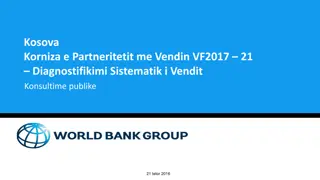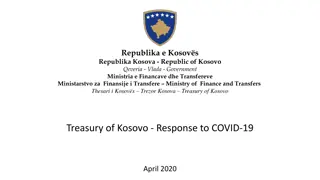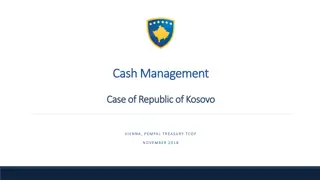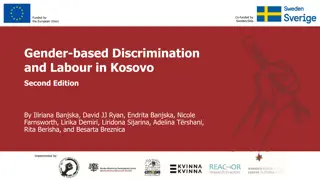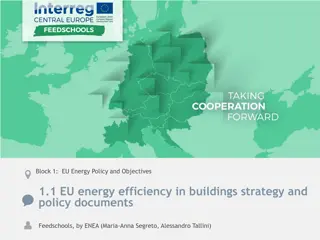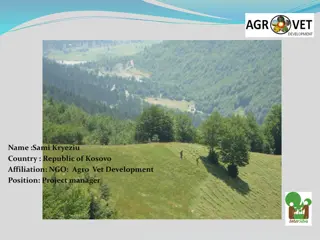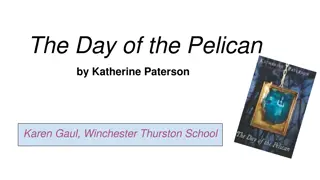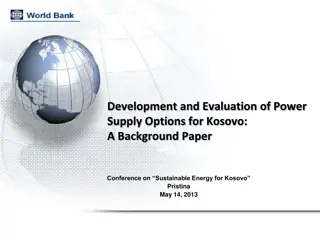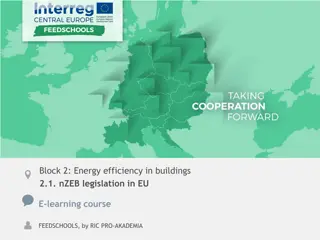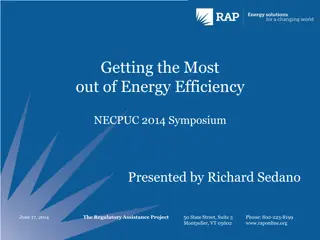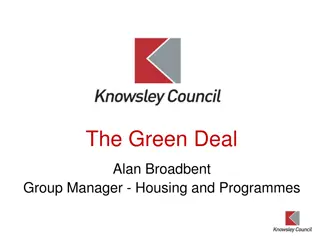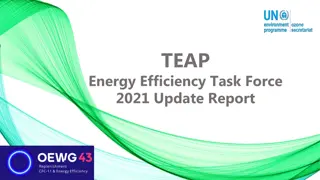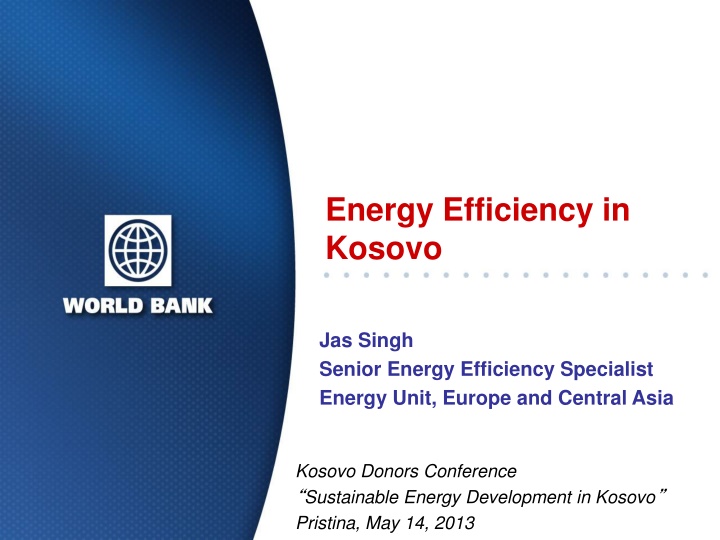
Energy Efficiency in Kosovo
Energy efficiency plays a critical role in Kosovo's sustainable development by enhancing energy security, reducing imports, boosting economic growth, and mitigating environmental impacts. With a significant potential for energy savings across various sectors, investing in energy efficiency not only brings financial benefits but also creates job opportunities and improves public health.
Download Presentation

Please find below an Image/Link to download the presentation.
The content on the website is provided AS IS for your information and personal use only. It may not be sold, licensed, or shared on other websites without obtaining consent from the author. If you encounter any issues during the download, it is possible that the publisher has removed the file from their server.
You are allowed to download the files provided on this website for personal or commercial use, subject to the condition that they are used lawfully. All files are the property of their respective owners.
The content on the website is provided AS IS for your information and personal use only. It may not be sold, licensed, or shared on other websites without obtaining consent from the author.
E N D
Presentation Transcript
Energy Efficiency in Kosovo Jas Singh Senior Energy Efficiency Specialist Energy Unit, Europe and Central Asia Kosovo Donors Conference Sustainable Energy Development in Kosovo Pristina, May 14, 2013
Importance of EE to Kosovo Energy security Reduces energy imports (Kosovo imported 572 GWh in 2012) EE is cheapest, cleanest domestic energy resource ( 1 invested in demand-side EE avoids over 2 in supply-side investments) Enhances economic growth Reduces large public expenditures in energy and energy subsidies, creating fiscal space for other development priorities Increases industrial competitiveness (EE reduces input costs) EE pays off recent German study found 1 in EE resulted in 4-5 in benefits (increased tax revenues, lower costs, reduced unemployment/ subsidies) and creates 15-19 jobs per 1 million investment Reduces environmental and social impacts of energy sector Positive health impacts from reduced air pollution Often least-cost way to reduce local and global air pollution Helps mitigate social impacts of tariff reforms 3
Potential for EE in Kosovo Energy Use by Sector 9% 2% 38% 26% Household Industrial Transport Agricultural Services 25% Source: MED, Energy Balance 2012 4
Potential for EE in Kosovo 9% indicative target set for NEEAP 2010-2018 2.2% total savings between 2010-2012 3% target set for 2013-2015 2012 (ktoe) 2018 (ktoe) Savings from measures** 28.05 Estimated savings from measures** 46.98 Sector Target* Target* Residential 12.40 30.64 Services 9.30 3.86 12.26 18.91 Industry 7.90 n/a 24.84 14.00 (TD) Transport 1.40 n/a 24.15 12.00 (TD) Total 31.00 31.92 91.89 91.89 Savings as % of base consumption 3% 3.1% 9% 9.0% Source: *1st NEEAP and 2nd NEEAP (first draft); ** Report on the implementation of the 1st NEEAP, 2010-2012, Kosovo 5
Potential for EE in Kosovo 38 EE measures included in 1st NEEAP period Concentrated in the residential and services sectors (public sector only) Includes select measures in the industrial, transport, agricultural sectors which account for 53% of energy use EE potential for building sector in Kosovo is large World Bank Institute (WBI) study found 47% of final energy consumption attributed to building sector and has an energy saving potential of 30-40%, 250 GWh/year 1.37 billion in investment needed for building sector (over 80% of investment needs are in the residential sector) Simple payback period for municipal and central government buildings is 4-5.3 years 6
Key Findings of WBI Study Building Sector EE Potential (% of primary energy supply) Total Area (million m2) Total Area (%) EE Potential (ktoe) BUILDING SECTOR 34.72 76.9 171.74 7.86 I. Residential 2.36 5.2 16.77 0.77 II. Municipal 0.18 0.4 3.60 0.16 III. Public Central 7.86 17.4 46.95 2.15 IV. Private & Commercial TOTAL 45.12 100.0 239.05 10.94 7
Key Findings of WBI Study Public Buildings MUNICIPALITY AND CENTRAL PUBLIC BUILDINGS Building Sector Total Area (m2) Energy Consumption (ktoe) Energy Expenditures ( m.) Energy Savings ( m.) 2,360,000 36.69 33.96 15.52 I. Public Municipality 1,690,000 23.48 21.73 10.09 Schools 393,000 8.07 7.47 3.10 Health Buildings 277,000 5.14 4.75 2.33 Other Buildings 182,000 7.34 6.79 3.33 II. Public Central 46,000 2.20 2.04 1.03 Central Hospitals 136,000 5.14 4.75 2.30 Central Government TOTAL 2,542,000 44.03 40.75 18.85 8
World Bank Global Experience in Energy Efficiency 9
Barriers to Energy Efficiency Investments Equipment/ Service Providers Policy / Regulatory End User Financiers Energy pricing and collections Procurement policies favor lower cost Import duties on EE equipment Unclear or underdeveloped EE institutional framework Lack of appliance standards and building EE codes, lack of testing, poor enforcement Limited and poor data High project development costs Limited demand for EE goods/services Diffuse/diverse markets New contractual mechanisms (ESCOs) Limited technical, business, risk mgmt. skills Limited financing/ equity Lack of awareness, high discount rates High upfront and project development costs Lack of ability to pay incremental cost Low EE benefits relative to other costs Perceived risks of new technologies/ systems Concept of EE is virtual cannot see Mixed incentives Behavioral biases Lack of credible data High cost of financing New technologies and contractual mechanisms Small sizes/widely dispersed high transaction costs High perceived risks not traditional asset-based financing Competing investment opportunities with higher return, lower risk projects Over-collateralization Behavioral biases 10
Typical EE Financing and Delivery Models Model / Sector Industrial Commercial Public Residential Utility Demand- Supply Management (DSM) Energy service companies (ESCOs) Commercial EE financing Public EE financing Market transformation Incentives, subsidies, grants Capacity building, awareness raising, education 11
Choosing the Right Instrument In public sector, for example, there are many options Market Maturity Commercial Financing + can address financing and implementation issues and build ESCO capacity Needs a mature market with operating ESCOs Advanced commercial financing (ESCOs) Commercial financing (loans/bonds) + can address financing issues needs municipalities with strong borrowing capacity + may scale up commercial financing needs mature banking sector and eligible borrowers; poor track record in several countries Partial credit or risk guarantees + Leveraging of private funds needs municipalities/ ESCOs that have borrowing capacity Dedicated credit lines + Can be structured to address financing needs and evolving capacity of municipalities challenging cost coverage from revenues EE funds/Public ESCOs + Easy to implement, can directly finance municipalities Institutional sustainability is questionable Budget financing with budget capture + Easy to implement, can directly finance municipalities Sustainability is questionable Budget financing/Grants Public Financing 12
Lessons Learned and Remaining Challenges Lessons Challenges EE is resource-intensive and requires a long-term focus Sector reforms have been crucial to create enabling environment and proper incentives for EE EE governance is critical to ensure strong policy/legal frameworks are in place and implementation is effective (e.g., time-based targets with clear accountability) Development of efficient delivery mechanisms (e.g., credit lines, ESCOs, utility programs, labeling schemes) are more important than technology Financing is available, but not always accessible and affordable Access to credible data and information, incentives, linking to other co-benefits (i.e., improved comfort) are also needed Cost reflective pricing and universal metering reforms remain slow EE investment needs are massive requiring increased focus on leverage Emerging EE agencies are politically weak and under-resourced Credit lines for industrial and commercial sectors need to act as market catalysts Need for more robust, scalable and sustainable models for EE in public and municipal buildings Region has underdeveloped energy service/ESCO markets, weak legal and regulatory frameworks, mixed track record EE cuts across all sectors, requiring better cooperation with urban, water, transport, agriculture, health, education sectors 13
WorldBankExperiencewithEEinWesternBalkans Recently implemented and planned projects total ~US$127 million for EE in public buildings Energy savings typically 30-45% per building, payback periods ~6-8 years Substantial co-benefits (improved comfort, urban renewal, public awareness, student education) Willingness to co-finance Lessons learned: Limited replication of donor pilots and grants without sustainable funding mechanisms in place Government project units orphaned after projects, loss of technical, implementation capacity High energy cost savings means that projects can and should repay upfront investments Difficult to scale-up; 20-30 buildings/year average 14
WorldBankExperiencewithEEinWesternBalkans Recommendations going forward Need to develop centralized, sustainable institutional structures to provide public financing and allow donor funds to revolve, capacity to be retained and sustained Need variety of instruments to serve both the creditworthy and poorer municipalities Need to boost leverage e.g., pooling of donor funds, requirements for co-financing, bring in some commercial financing More aggressively foster ESCOs and commercial financing structures Need to better bundle buildings to scale-up impacts Need to shift from project-based planning to programs with an emphasis on achieving macro goals (e.g., NEEAP targets) Need to better link policy and regulatory measures with project- level investments, need enforcement pressures to encourage investments 15
Key Policies and Actions Taken by Kosovo Obligates MED and municipalities to prepare EE action plans; MED to set up EE Agency and fund EE initiatives Law on Energy Efficiency Kosovo Energy Efficiency Agency Established in April 2012 to implement the Energy Efficiency Law As committed to under Energy Community Treaty, indicative targets for EE savings set at 9% by 2018; updated every 3 years NEEAP 2010-2018 Approved October 2010: Determines EE targets, encourages advanced metering systems, provides EE policy framework and subsequent implementation Law on Energy Approved October 2010: Defines functions electricity market components and prepares for market opening (in line EU requirements) Law on Electricity Approved in 2010: ERO currently managing transition from single year to multi year tariff setting methodology Law on the Energy Regulator Important features related to energy performance of buildings: Building code norms for new and renovation works, implementation of EE measures, certificate of compliance with EE measures Law on Construction MED support for measures defined in KEEP (seeking financial support from public budget, international organizations and donors) Energy Efficiency Measures Funding Under Law on EE, Municipal Energy Offices required to develop Municipal EE Plans and Implementation Progress Reports (GIZ working with KEEA on 10 plans under EU funded project) Series of secondary legislation adopted (e.g., appliance labeling, energy auditing, etc.) Municipal Energy Efficiency Plans Secondary Legislation 17
What are Donors Doing? Industrial / Commercial Public Sector Residential Study and Implementation of EE measures in municipalities (30 buildings; EU and KfW financed) Support to Pristina DH system, cogeneration Pursing promotion of residential EE through bank loans KfW Grant-funded municipal EE project (63 schools, 2 hospitals) Assistance to MED (staff training, NEEAP) (completed) Public awareness campaign for EE (completed) TA to update, monitor and evaluate NEEAP EU Creation of credit line in SME/ buildings sector Assessing credit line (microloans) for households EBRD Modernization of municipal buildings (completed in select municipalities) Public lighting modernization plan developed in several municipalities GIZ Study and implementation of EE in public buildings (centrally-owned) Review of financing options for public EE (WBI) Review of financing options for residential EE (WBI) World Bank 18
Framework for Successful Energy Efficiency Programs Policy and Regulations Institutions Overarching EE legal framework (EE Law) Cost-reflective energy pricing Codes/standard w/ enforcement mechanisms EE incentive schemes w/ funding sources EE targets by sector Public budgeting/procurement encourages EE Dedicated entity with EE mandate Clear institutional roles/accountability Inter-ministerial coordinating body Assignment of roles for monitoring and compliance enforcement Authority to formulate, implement, evaluate and report on programs Tracking on progress for EE targets Information Finance Database on energy consumption Industrial and building stock Information center/case study database Database of service providers, EE technologies, equipment providers Broad, sustained public awareness Appliance labeling Commercial bank lending (credit lines, guarantees) Cashflow-based EE financing Commercial ESCO financing Public sector EE financing Residential home/appliance credit Equipment leasing Technical Capacity Energy auditor/manager training and certification programs Private sector training programs (banks, ESCOs/EE service providers, end users) EE project templates (audits, M&V plans, EPC bidding documents, contracts) Energy management systems developed 19
What are the Remaining Gaps? o Develop additional secondary legislation, rulebooks and enforcement mechanisms o Enhanced EE incentive schemes for private sector end users, with dedicated funding sources o Enabling environment for EE in public sector (procurement, budgeting) o Database of end users, consumption information o Sector and sub-sector EE potential and market studies (e.g., transport, industry) o Information center (e.g., case studies, EE projects, EE service providers, technologies/equipment suppliers) o Broad, sustained awareness campaigns Policy and Regulation Information o Ongoing institutional capacity enhancements for KEEA o Develop program functions within KEEA (e.g., program formulation, implementation, evaluation, monitoring/tracking) o Enhance government capacities for enforcement Institutions o Develop/Implement certification scheme for energy auditors, energy managers o Development of project guides, ESCO bidding/contract models, M&V protocols, audit/baseline templates o Sustained training to private sector (end users, ESCOs, banks) o Platforms to share implementation experiences, project information o Increased capacity building with municipalities for EE planning, implementation, reporting Technical Capacity o Creation of suitable public financing scheme for municipalities (e.g., EE revolving fund) o Industrial/SME and residential EE credit schemes o Cashflow and ESCO financing bank product development Financing 20
Addressing the Gaps Government of Kosovo: Develop and adopt needed secondary legislation, new EE Directive Improve district heating supply, DH metering and billing, judicious DH system expansion Seek measures to continually move towards cost reflective pricing Create suitable public sector financing mechanism (e.g., EE revolving fund) Develop programs, incentives for all sectors for EE, particularly for households Assess EE savings potential for additional sectors (e.g., transport, industry) Launch broad, sustained raising of public awareness on EE Strengthen KEEA Donors: Support development additional legislation, rulebooks based on international best practices Help to design and implement appropriate financing and incentive schemes Assist to identify investment needs for total EE potential and by sector Support capacity building with KEEA and municipalities Develop database on end users, consumption Help create database of service providers, EE technologies, equipment providers Provide private sector training programs (banks, potential ESCOs/EE service providers, end users) Share EE project templates (audits, M&V plans, EPC bidding documents, contracts) 21
Thank you 22


